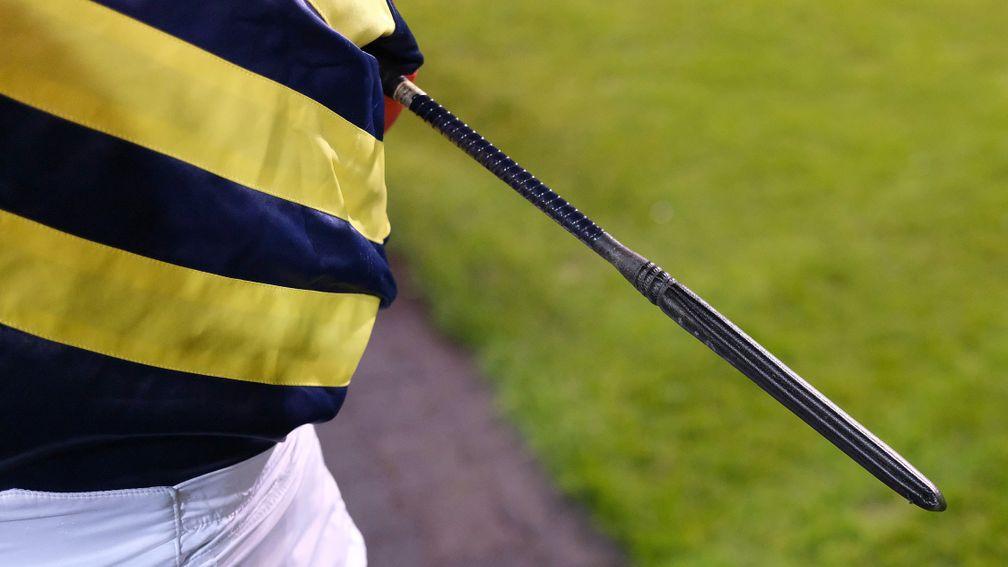- More
From 1889 to the present day: how the whip rules have evolved down the years

1889
First mention of the whip in the rules. It is not to be included in the weight carried.
1948
No substitute for a whip to be carried in any race.
1972
Angled spurs disallowed.
March 1980
Irish champion jockey Joe Byrne and compatriot Tommy Ryan were suspended for three months for their "excessive and improper" use of the whip at the Cheltenham Festival.
January 1981
The Turf Club issues whip guidelines, stating: "There has been a growing tendency for some riders to become dependent on the use of the whip as the only aid to obtaining maximum performance from horses. This tendency is deplored because it is unnecessary and in fact could be construed as cruelty."
1985
First attempt to define an approved design for the whip. The stewards publish examples of what they regard as improper use of the whip and state the trainer is responsible for giving instructions on the use of the whip.
March 1988
Jimmy Duggan becomes the first jockey to fall foul of new Jockey Club rules introduced to reduce the use of the whip. The rules, which came into force in late March, meant stewards would inquire into cases where a jockey hit a horse more than ten times in the last two furlongs of a Flat race and after the penultimate obstacle of a jumps race. A first offence in the current season would trigger a suspension of two to four days, with a second offence deemed worthy of two to 14 days. A third or more offence would be sent on to Portman Square.
Jockeys refuse to cooperate with TV interviews on opening day of Flat season at Doncaster.
1997
The design of approved whips is refined and must include "shock absorbing characteristics" with a compression factor of at least six millimetres. The stewards state "the whip should be used for safety, correction and encouragement only".
2003
The stewards provide tighter definitions of dangerous riding, improper riding and accidental interference with regard to the use of the whip.
November 2010
The BHA, with the involvement of the PJA and RSPCA, begins an examination into the effectiveness of whip rules and penalties.
Before 2011
Between 2005 and 2011 the number of permitted hits is identified. In Flat races it is nine in the last furlong and 16 in the whole race. In jumps races it is ten after the last obstacle and 16 in the whole race.
April 2011
Media coverage of the Grand National, in which two horses died and the winner required water and oxygen, also highlights the five-day ban given to Ballabriggs' jockey Jason Maguire, who hit the horse 17 times on the run-in, leading to some calls for the implement to be banned.
The BHA announces a review to establish acceptable use of the whip with the intention of publishing and implementing the agreed actions by October 2011.
September 2011
The BHA concludes its review and announces strict limits on the number of times horses can be hit with the whip and minimum penalties of five-day suspensions to come into force from October 10. Offending riders will also lose riding fee and share of prize-money but the changes garner broad support across the sport, including among jockeys.
October 2011
The BHA's last formal review of the whip resulted in the introduction of strike limits, with seven strikes with their hand off the rein in a Flat race and eight over jumps – with no more than five strikes permitted in the final furlong or after the last hurdle/fence – before a sliding scale of punishment kicks in depending on how far over the limit riders go. The existing rules have resulted in a reduction in offences. By 2020 there were 297 suspensions for whip offences, down 52 per cent from 2010, with 203 of those for the one-to-two day minimum (down 54 per cent), 68 bans were three to six days (down 57 per cent) while 26 bans were for seven days or more, an increase of 13 per cent on 2010.

October 2011
On the first day of the new rules Kieren Fox is banned for 15 days and Richard Hughes five.
Four days in and after three more riders fall victim to the rules, the BHA chairman Paul Roy announces a reconvening of working party to consider concerns of riders, who include Tony McCoy and Frankie Dettori.
After Hughes was found in breach again, receiving a ten-day ban that rules him out of the Breeders' Cup, the jockey momentarily quit the saddle in protest at the five strikes inside the final furlong element of the rule.
The PJA petitioned the BHA to drop this element of the new rules and they were successful, with the rule amended two weeks after being introduced. They also amended the element that required jockeys to forfeit their share of prize-money if they were banned for three days or more, with that not kicking in until the ban was for seven days or more.
February 2020
The Horse Welfare Board's strategic plan 'A life well lived – a new strategic plan for the welfare of horses bred for racing 2020-2024' was announced, stating it would look to establish potential policy reforms relating to the use of the racing whip and any associated rules and/or regulatory changes.
October 2020
Owner Kulbir Sohi opted to legally challenge the current "toothless" whip rules after his horse Tranchee, the 9-2 favourite trained by Dave Loughnane, finished second to Gulliver, ridden by Martin Harley, in the £75,000 Coral Sprint Trophy at York. Harley, who was fined £1,350 and suspended for nine days, used his whip 12 times inside the final two furlongs. Sohi stated disqualification was the only means to rigorously ensure all jockeys ride within the rules.
July 2021
The BHA announces a new consultation into the use of the whip, first mooted in 2018 after that year's Cheltenham Festival, will commence with an online questionnaire running from July to September, followed by focus groups and detailed discussions in August and September, data assessment through the autumn, recommendations proposed and further industry discussion through the winter. The initial plan is to get plans signed off by the board in February with the report and findings published, allowing for bedding in through the spring and implementation from late spring. The "logistical issues caused by Covid and the impact on the schedules of this wide range of individuals" were cited by the BHA as a reason for the schedule sliding.
April 2022
Sam Waley-Cohen wins the Grand National despite using his whip down the shoulder or on his horse's hindquarters 14 times. Waley-Cohen's immediate retirement rendered the punishment of a nine-day suspension and a £400 inconsequential.
Reporting by Lee Mottershead, Jack Haynes and Stuart Riley
Read these next:
Full story: backhand whip use only and disqualification to be introduced in new whip rules
Reaction: 'It does not go far enough' – charity criticises whip review despite involvement
Explainer: the current rules and why there's a perceived need for change
Key jurisdictions: what are the whip rules in other countries?

The Front Runner is our latest email newsletter available exclusively to Members' Club Ultimate subscribers. Chris Cook, a four-time Racing Reporter of the Year award winner, provides his take on the day's biggest stories and tips for the upcoming racing every morning from Monday to Friday
Published on inBritain
Last updated
- Cheltenham ground quickens to good to soft, good in places on Thursday with weekend weather set fair
- Labour vice-chair of parliamentary racing group calls for 'urgent action to arrest financial decline' of the sport in Britain
- 'He won't be too far away' - Harry Fry hopeful In Excelsis Deo can bounce back in December Gold Cup
- The jockeys and trainers with the best records at Cheltenham this season - and their main chances at the December meeting
- 'You need to keep your powder dry' - Aidan Coleman on Cheltenham's two tracks as action switches to the New course
- Cheltenham ground quickens to good to soft, good in places on Thursday with weekend weather set fair
- Labour vice-chair of parliamentary racing group calls for 'urgent action to arrest financial decline' of the sport in Britain
- 'He won't be too far away' - Harry Fry hopeful In Excelsis Deo can bounce back in December Gold Cup
- The jockeys and trainers with the best records at Cheltenham this season - and their main chances at the December meeting
- 'You need to keep your powder dry' - Aidan Coleman on Cheltenham's two tracks as action switches to the New course